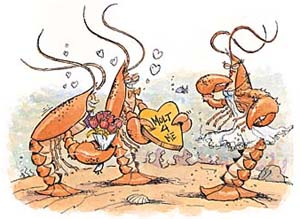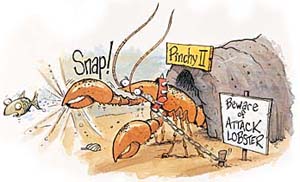 |
 |
| current issue |  |
past issues |  |
send a letter/news |  |
address update |  |
advertise |  |
about us |  |
alumni home |
Features
Crustaceans with AttitudePage 3 of 3
One Life to Live
Although Watson has had a number of firsts in lobster research he is best known, nationally and internationally, for creating a crustacean version of reality TV. With the help of UNH ocean-engineering students, Watson, UNH zoologist Hunt Howell, and Steve Jury '88, '99G devised a way to monitor a baited lobster trap for 24 to 48 hours at a time with a with time-lapse video camera set-up dubbed Lobster Television, or LTV. The resulting videos resemble old-fashioned silent movies, with lobsters lurching about the trap like Keystone Crustaceans. (To watch some of the videos, visit < http://www.lobsters.unh.edu>.)
 Illustration by Kevin Rechin |
The lobster trap in use today, whether made with vinyl-coated wire or wood slats, was designed in the 1830s. There are two one-way entrances into the "kitchen," where a bag of salted herring hangs. Lobsters, believed to be nocturnal, were expected to eat and then move into a separate compartment called the "parlor," with exits designed to allow sublegal-sized lobsters to escape. For years, scientists based their lobster-population estimates on surveys of lobsters caught in traps even though there was no documentation of the correlation. The surprising evidence provided by LTV has dramatically changed how fishery managers look at lobster-trap surveys.
In their study, Watson and Howell found that only about 10 percent of the lobsters around the trap entered, and a mere 6 percent of the lobsters who entered were caught, largely because they had the bad luck to be in the trap when it was hauled up. Instead of a Crustacean Hotel where the lobsters would "check in and never check out," the lobster trap works more like a 24-hour roadhouse where the patrons are generally free to leave -- usually through the supposedly one-way entrance. The brawling customers are constantly chasing each other out or scaring others off at the doorway. As usual, the lobster with the biggest claws wins. To Watson, they are "ornery, solitary animals who are angry all the time."
Diane Cowan sees a very different side of lobsters. The mating behavior she observed in two large tanks looked a lot more like "One Life to Live" than something out of "The Wild Wild West."
 Illustration by Kevin Rechin
Illustration by Kevin Rechin
|
A lobster begins its potentially long life by going through seven to eight years of juvenile stages, molting once or more a year and expanding in size by roughly 12 percent every time. Before reaching adulthood, Cowan discovered, lobsters pass through a flirtatious adolescent period that stops short of mating, perhaps in recognition of the commitment it takes to carry thousands of eggs around on one's swimmerets for a year. Adults continue to grow slowly and molt occasionally, scientists believe, for up to 100 years.
Among the lobsters Cowan studied was a male she discreetly named "M." When a female -- let's call her "Q" -- has a tryst with M, she announces her arrival at the entrance to his den with a squirt of urine laced with pheromone, a chemical attractant. Once inside, she undresses in a most dramatic fashion, wriggling entirely out of her shell, and then lies limp as a dishrag for half an hour, pumping water into her new shell. M, resisting the urge to dine on lobster, stands quietly by. Then he gently flips her over and cradles her with his walking legs while they mate in a matter of seconds. Afterwards, they dine on Q's cast-off shell, a delicacy among lobsters, and Q safely rests in the shelter for a few days until her shell has hardened enough to withstand the lobster-eat-lobster world outside.
Not long after Q and M's rendezvous ends, another female lobster will appear, ready to boogie. In fact, the females appeared to time their molting to occur in succession, each visiting M in a pattern Cowan termed "serial monogamy." "People have described lobsters as solitary," she says, "but I consider them highly social. They know where their neighbors live and know what molt stage they're in. It's not just whether an animal has a backbone or not that makes it simple or complex."
Cowan and Watson are now seeking a grant to take the mating research a step further out into the experimental environment where Watson studies homing behavior. His tracking studies suggest that males may set up mating territories, possibly defending multiple females in multiple shelters. By using identifying sonar tags with transmitters, Watson believes, they could really keep tabs on lobsters in love.
Boom or bust?
When he gets home from a day at sea, Dan Millar often lies down on the floor to get the kinks out of his back. "I already know what rigor mortis is," he says with a laugh, "and I don't think I'm going to enjoy it." Millar's boat, F/V Rewben, is named after his sons, Andrew and Benjamin, who he hopes will not follow in their father's footsteps. "This business is too hard," he says. "Your average work week is 60 hours, easy." Which is not to say that Millar is bitter. For one thing, the money hasn't been bad. Carl Wilson '95, chief lobster biologist for the state of Maine, estimates that the typical Maine lobster boat grosses $200,000 to $300,000 a year and supports two families. Like most lobstermen, however, Millar seems to be in it less for the money than the independence -- which allows him to attend many of his sons' ball games.
In spite of the record lobster landings of recent years, Millar worries that a downturn is inevitable. He has already seen a few cases of the bacterial shell disease that is disfiguring, but not killing, lobsters in southern New England waters (under study by UNH assistant professor of microbiology Elise Sullivan). Wilson, Cowan and Watson share his concern, pointing out that 80 percent of the lobsters caught in Maine are just above the legal limit, which means, according to research done by Watson and others, that only 50 percent of those lobsters have reached the age of sexual maturity.
Is the lobster population booming or at risk of sudden collapse? Are lobsters being over fished or carefully tended? Are they sensitive neighbors or angry hermits? The answer thus far may be something like "all of the above." Scientists, regulators and fishermen are a bit like the proverbial blind men groping their way around an underwater elephant. The contradictions they find may just be different views of a complex creature fished by complex people trying to maintain a fishery in a complex world. In the meantime, Watson and his collaborators will keep using technology, creativity -- and duct tape -- to piece together more of the lobster puzzle. ~
Page: < Prev 1 2 3Easy to print version
blog comments powered by Disqus

